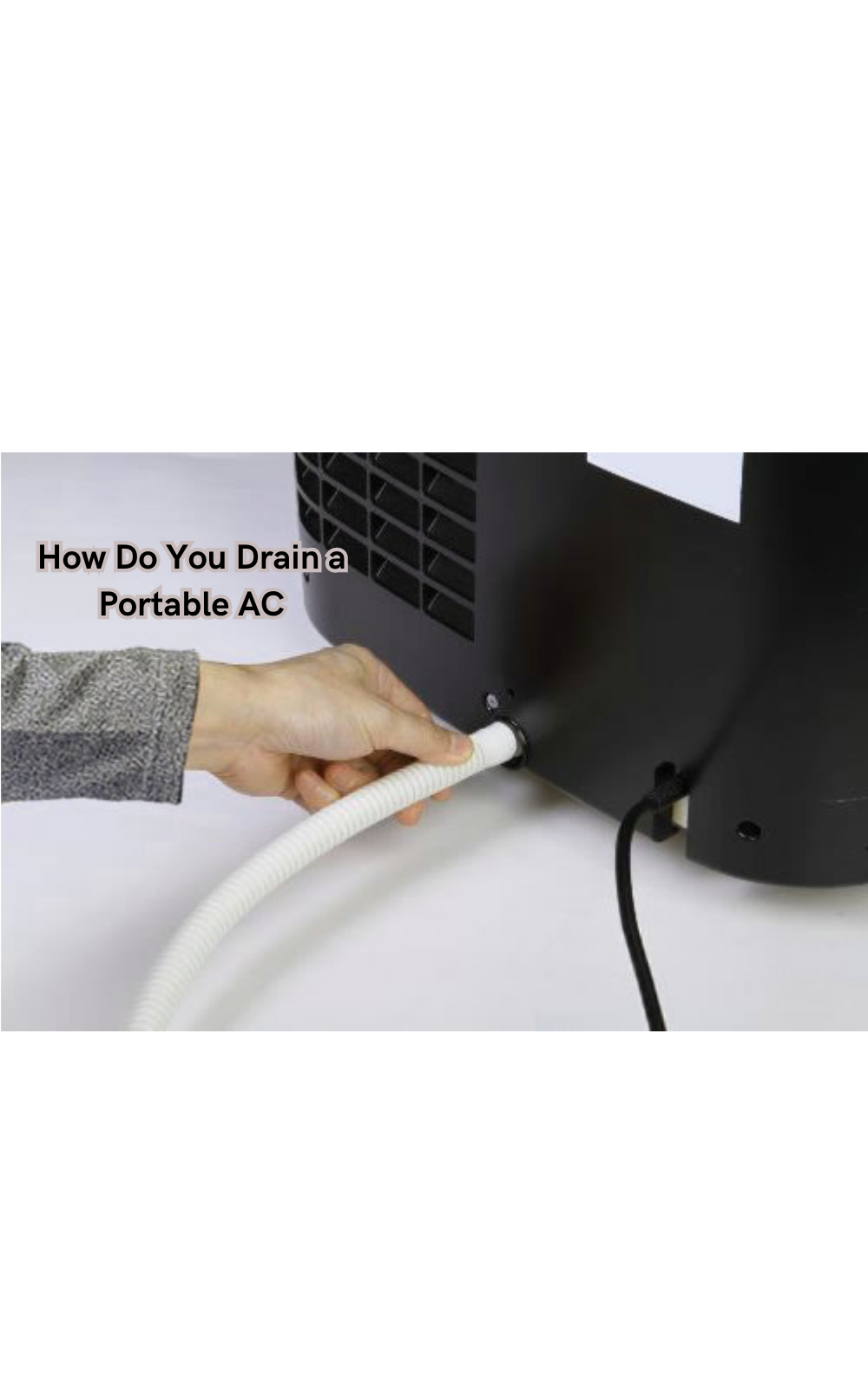How Do You Drain a Portable AC

Draining a portable air conditioner (AC) is a vital process that ensures the unit operates efficiently and extends its lifespan. As portable ACs cool the air, they collect water, leading to water damage, mold growth, and reduced performance if not drained regularly. Proper drainage prevents water accumulation, reducing noise and vibration.
This guide will provide a step-by-step approach to draining a portable AC, empowering you to maintain your device effectively. By following these simple steps, you can easily drain your portable AC and keep it running smoothly.
Overview of Portable AC System
A portable AC unit has three main parts: the compressor, condenser, and evaporator. The system works by extracting heat from the air in a room, cooling it down, and returning it to the environment. As hot air passes over the evaporator coils, the refrigerant absorbs heat and turns into gas.
The gas then flows to the compressor, which is compressed and turned into a high-pressure vapor. The condenser then cools the vapor, turning it into liquid form, which is pumped back to the evaporator to repeat the cycle.
Why Do You Need to Drain a Portable AC?
When running, a portable AC produces cool air by drawing moisture. This moisture collects in a reservoir or tank at the unit's bottom. If left unattended, this water can overflow and cause damage to your floors or furniture.
Additionally, stagnant water in the reservoir can become a breeding ground for mold and bacteria, leading to potential health hazards. Floor drain systems are unavailable in portable ACs, so manually draining the unit regularly is crucial.
Moreover, accumulated water inside a portable AC can also affect its performance. The system has to work harder to cool down the air, so it may consume more energy and lead to higher utility bills. Draining the AC regularly can prevent these issues and keep your unit functioning at its best.
How Often Should You Drain a Portable AC?
The frequency of draining your portable AC depends on how often you use it and the humidity levels in your room. Generally, if you use your AC daily, you should aim to drain it at least once a week.
If you live in a humid climate or use your AC more frequently, draining it every few days may be necessary. It's also essential to monitor the water level indicator inside the unit and drain it whenever it reaches the maximum level.
Portable air conditioners have a user manual that provides specific instructions on when and how to drain the unit. Portable AC units also have a drainage port, making the process more manageable.
Modern portable air conditioners also have self-evaporating technology, reducing the frequency of manual draining. Automatic draining systems are available in some high-end models, making the process even more convenient.
How Do You Drain a Portable AC? Step-by-Step Guide
Now that you understand the importance of draining your portable AC let's dive into the step-by-step process of doing it safely and effectively.
Step 1: Understand Your Portable AC's Drainage System
The first step to effectively draining your portable AC is understanding its drainage system. Not all portable ACs have the same setup, so it's essential to refer to your unit's manual for specific instructions. Generally, there are three types of drainage systems in portable ACs: gravity drain, condensate pump, and self-evaporative technology.
- Gravity Drain: This is the most common drainage system in portable ACs. It requires you to manually drain the water collected in the reservoir using a hose or by emptying the tank.
- Condensate Pump: Some portable ACs come equipped with a built-in pump that automatically pumps out excess water through a drain hose.
- Self-Evaporative Technology: This type of drainage system uses excess water to cool down the condenser coils, eliminating the need for manual draining. However, these systems are not completely self-sufficient and still require occasional draining to maintain their efficiency.
Humid air is expelled from the exhaust hose, and any condensed moisture is typically vented through a window or wall. Ensure that your portable AC drainage system is suitable for your specific needs before making a purchase.
Step 2: Prepare Your Draining Equipment
Once you understand your unit's drainage system, gather all the necessary equipment before starting the process. This may include a drain hose, a bucket or container to collect water, and towels to clean up any spills.
Step 3: Locate the Drain Port
The drain port is typically located at the bottom of the unit. It may be covered by a cap or plug, which you will need to remove to access the port. The upper drain plug is generally present in a portable air conditioner.
Step 4: Connect the Drain Hose
If your portable AC has a gravity drain or condensate pump system, you will need to connect the drain hose to the unit's drain port. Ensure that the hose is securely attached and placed in a location where it can easily drain excess water.
Step 5: Place Your Drainage Container
If your portable AC does not have a built-in condensate pump, you will need to place a container or bucket beneath the drain hose to collect the water.
Step 6: Open the Drain Valve
For gravity drain and condensate pump systems, you will need to open the drain valve by turning it counterclockwise. This will allow the excess water to flow out through the hose and into your drainage container. The lower drain plug is generally connected to the tank and air filter.
Step 7: Close the Drain Valve
Once all the water has been drained, close the drain valve by turning it clockwise.
Step 8: Clean and Dry Your AC
After draining the excess water, clean any remaining moisture or debris from the unit's interior with a towel. Use a damp cloth to wipe down the exterior and dry it thoroughly.
These steps should be repeated regularly, depending on your specific needs and the recommendations in your unit's manual.
Tips for Efficient and Hassle-Free Drainage
- Regularly clean and replace your AC's air filters to prevent clogs and improve the unit's efficiency.
- Keep an eye on the water level indicator and drain your unit whenever it reaches the maximum level.
- Place a towel or mat underneath your portable AC to catch any potential spills during the draining process.
- If you live in a particularly humid climate, consider investing in a portable AC with automatic draining capabilities to make the process more convenient.
Follow these tips, and you can ensure that your portable AC remains in top working condition for years to come. Cooling mode and heating mode are present in most new models of portable air conditioners. By properly draining your unit, you can enjoy comfortable temperatures without the hassle of high utility bills or potential damage to your AC.
Benefits of Portable AC
Now that you know how to drain a portable AC, let's look at some of the benefits of using one. Apart from their versatility and ease of use, portable ACs offer a range of benefits, such as:
- Cost-effective alternative to central air conditioning systems. Portable ACs are generally more affordable to purchase and operate than traditional air conditioning units.
- Provides targeted cooling. Unlike central air conditioning, which cools the entire house, portable ACs can be moved from room to room, providing cool air where you need it most.
- No installation is required. Portable ACs are easy to set up and do not require any permanent installation, making them perfect for renters or those who live in small spaces.
- Energy efficiency. Many portable ACs come with energy-saving features, such as programmable timers and eco modes, helping to reduce your utility bills.
- Humidity control. Portable ACs not only cool the air but also remove excess moisture, creating a more comfortable and healthy environment.
FAQs
What happens when a portable AC is full of water?
When a portable AC is full of water, it can cause the unit to become less efficient and may even lead to malfunction if not drained in a timely manner. Excess water in the reservoir can also result in spills and leaks, causing potential damage to your floors or furniture.
Where does the water go with a portable air conditioner?
The water collected in a portable air conditioner is either manually drained through a hose or pumped out using a built-in condensate pump. Some units also have self-evaporative technology that uses excess water to cool down the condenser coils. The remaining moisture is typically vented out through a window or wall.
Why are there two drain plugs on a portable AC?
There are typically two drain plugs on a portable AC to provide different options for draining the excess water. The upper drain plug is used for gravity draining or connecting a condensate pump, while the lower drain plug is connected to the tank and air filter for manual draining.
Can you leave a portable air conditioner on all day?
Yes, you can leave a portable air conditioner on all day, but it's recommended to turn off the unit when not in use for extended periods. This will save energy and reduce wear and tear on the unit.
Conclusion
In conclusion, maintaining a portable AC drainage system is essential for efficient operation and longevity.
Regularly draining the condensate helps prevent water buildup, mold growth, and performance issues. To drain a portable AC effectively, locate the drainage outlet, position a container beneath it, unplug or remove the stopper, and let the water flow out.
By prioritizing this simple maintenance task, you can enjoy consistent cooling comfort while safeguarding your portable AC from potential damage. Stay proactive with drainage to keep your portable AC running smoothly and efficiently.
